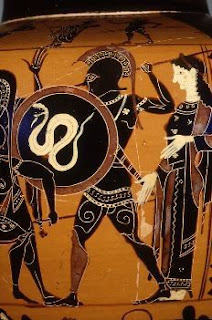Actual Play II: The Trial of Ares
 |
| Athenian Black Figure Circa 6th Century BC |
The Trial of Ares
Mighty Lycaneous was once a great captain in Sparta. He had an impressive strength of 18, but a less impressive wisdom of 5. The player and I concluded that Lycaneous was struck down in a battle before the campaign started. The severe head trauma left him quite insane. The player acted up the insanity well. He was so overly confident that he believed there was no threat he could not take head on. Convincing him not to kill someone was very difficult and his hubris would lead to troubles down the line.
When they arrived in Sparta, the heroes chose to speak with King Menelaus to discuss where they could find the Stone of Ares. However, they received a less than warm welcome. Menelaus was still furious about the chaos Lycaneous had caused when he left Sparta. Lycaneous was a wanted man for his crimes. In response, the Son of Ares demanded that he face the charges being made against him, and demanded a trial by combat.
Menelaus decided to grant this request, summoning forth his champion. Lycaneous was charged with treason, the rest of the heroes were charged with aiding an enemy of the state. Everyone adjourned to the arena where the heroes were met by the Menelaus’s champion. He was a great beast of a man, twisted and hideous. He had the horns of a goat, his body covered in hair, he had a sweeping tail, and cloven hooves. For those of you paying attention, he is none other than Calibos, the villain from the 1981 Clash of the Titans! I had recently watched the film to prepare myself for the campaign and loved the look of Ray Harryhausen’s creature. Obviously, none of my students caught on.
The heroes slayed the beast, clearing Lycaneous’s good name. Menelaus was good to his word, and awarded them the location of the Stone of Ares. Which was in an abandoned rock quarry a few miles outside of Sparta. When the heroes arrived they discovered an empty quarry, with a single blood red stone. As they approached the stone they were beset by vengeful dead spirits springing forth from the ground (they were skeletons). Once the heroes fought their way through the spirits, Lycaneous could finally claim his reward.
The Stone quickly became Lycaneous’s favorite weapon. He used it all the time. He loved to rage and come smacking monsters with it. He gleefully smashed any heads that stood in his path or threatened his friends. However, the stone bears upon it a curse. Those who pursue violence can be overwhelmed by it. There was a time, when Lycaneous was raging, that he rolled a Nat 20 and the group cheered his success. However, he made his Wisdom saving throw (with only a Wisdom of 5) and failed miserably. Soon he turned on his friends. This was a famous moment in which he almost killed one of his allies w by throwing the stone at their face. Saphildur the Blue had to put him down with a sleep spell. After that, they always kept a sleep spell ready in case Lycaneous ever lost control again.
The Stone of Ares
The Stone of Ares is ancient beyond belief, the very first weapon to be used by a man to kill another man. It fits comfortably in the palm of your hand and has sharp point to it. It is a +1 bludgeoning weapon that deals 1d12 damage. Besides working as a melee weapon, the Stone of Ares can also be thrown up to 20 ft.
When a character rolls a critical hit, they must make a DC 12 Wisdom save, or be overcome with a murderous rage for the next 1d4 rounds. The wielder of the Stone of Ares will attack whoever is the closest, even if they are an ally, until the target is dead, or the wielder has been rendered dead or unconscious.
Characters who wish to upgrade the stone from a +1 weapon to a +2 weapon, must succeed in a sacrificial ceremony to Ares. They must sacrifice a black ram at a Temple of Ares or other site holy to him, allowing the blood of the sacrifice to pour over the stone. The stone will drink in the blood like a sponge.
DM TIP: TABLE TENTS
Quick sidebar: I encourage all DMs to make table tents for their players (or more specifically, have your players make their own table tents). It’s a simple thing, take a piece of paper and fold it into thirds, allowing it to rest like a triangle. On one of those sides have the players write their character’s name on it. From here on out, only refer to those players by their character names. My students got really pushy when I would accidentally call them by their real name during a game of DnD. This really helps them with their immersion in the game, and is simply more fun! In my opinion it is just less fun when someone says “Billy, what are you going to do?” unless their character’s name is Billy. Then it’s fine.



Comments
Post a Comment